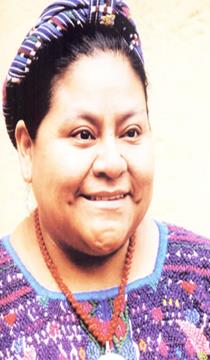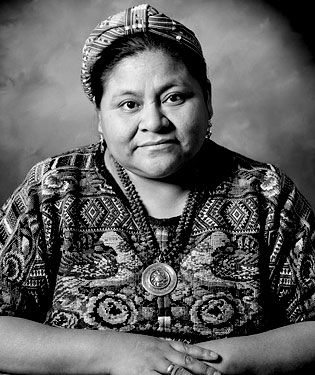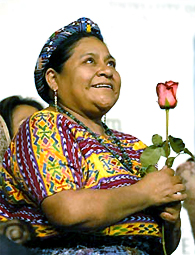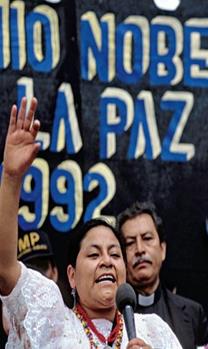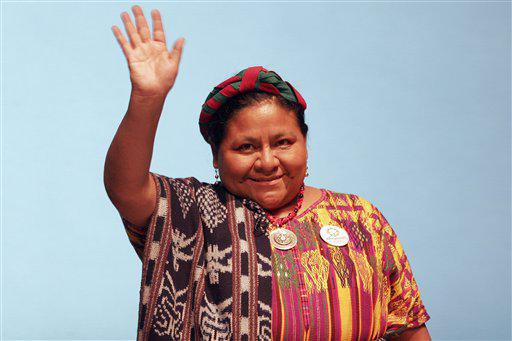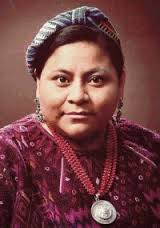
Rigoberta Menchu Tum
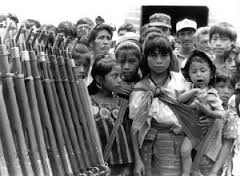
Link to Slide 5
Link to Slide 4
Link to Slide 6
Link to Slide 7
Link to Slide 8
Link to Slide 3
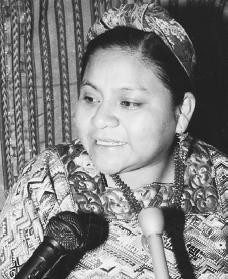
Link to Slide 9
Activist | Politician
1959
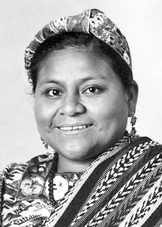
Rigoberta Menchu Tum
Rigoberta Menchu
About
scroll down to view more
Rigoberta Menchu Tum was born on January 9, 1959 in a small town named Chimel. She has spent her entire life working on the rights of Guatemala's peoples during and after the Guatemalan Civil War. She is well known for her testimonial biography: I, Rigoberta Menchu. She is also a Nobel Peace Prize winner.
1954
The U.S. Central Intelligence Agency backed a coup commanded by Colonel Carlos Castillo Armas against the democratically-elected president, Jacobo Arbenz.
1960
1966
Civilian rule was restored to Guatemala and Cesar Mendez was elected president, but the civil war only intensified with a major counterinsurgency campaign by the army.
1970
Military-backed Carlos Arana was elected president, and he immediately placed the country under a state of siege, giving the military more control over civilians. For the next decade, a series of military-dominated governments escalated violence against guerilla groups and indigenous communities.
More than 200,000 people were killed over the course of the 36-year-long civil war
About 83 percent of those killed were Mayan
Guatemala is led by President Álvaro Colom of the National Unity for Hope. Almost 15 years after the end of the civil war, violence and intimidation continue to be a major problem in political and civilian life. Organized crime groups operate with relative impunity.
TODAY
Guatemalan Civil War*
Key Events 1954-1996
Facts*
1981
1982
1985
1993
Guatemala’s civil war began as left-wing guerilla groups started battling government military forces. The country was now under rule by Gen. Miguel Ydigoras Fuentes, who assumed power in 1958 following the murder of Col. Castillo Armas.
The Inter-American Human Rights Commission released a report blaming the Guatemalan government for thousands of illegal executions and missing persons in the 1970s, and documenting accounts of the slaughter of members of Indian communities.
The Inter-American Human Rights Commission released a report blaming the Guatemalan government for thousands of illegal executions and missing persons in the 1970s, and documenting accounts of the slaughter of members of Indian communities.
A new constitution was drafted and democratic elections for president resumed two years after Montt was ousted in another coup.
Then-President Jorge Serrano illegally dissolved Congress and the Supreme Court and restricted civil rights, but was later forced to resign..
1994
1996
Under President Ramiro De Leon Carpio, the former human rights ombudsman, peace talks between the government and rebels of the Guatemalan Revolutionary National Unity began and agreements were signed on several issues including human rights.
A new president, Alvaro Arzu, was chosen in a runoff election. Under Arzu peace negotiations were finalized. Peace accords ending the 36-year internal conflict were signed in December of 1996.
93 percent, of human rights violations perpetrated during the conflict were carried out by state forces and military groups.
U.S. involvement in the country was also singled out by the commission as a key factor contributing to human rights violations, including training of officers in counterinsurgency techniques and assisting the national intelligence apparatus.
*Timeline events and facts taken from PBS, Timeline: Guatemala's Brutal Civil war.
She was born to a poor Indian family and was raised in the Quiche branch of Mayan culture.
Early Life
Her father, Vicente Menchu was a community leader and her mother, Juana Tum was a midwife and healer.
She was the sixth of nine children.
scroll down to view more
Growing up, during the year, Rigoberta and her family would leave for a period of six months to work on coffee, cotton, and other plantations along the Southern Coast of Guatemala.
Plantation owners treated mayan workers poorly. Most workers were in the hot sun for 14 hours and were paid only pennies for their service.
Rigoberta became involved in social reform, following in the footsteps of her father. Shewas just a teenager and joined social reform activities through the Catholic Church.
"What I treasure most in life is being able to dream. During my most difficult moments and complex situations I have been able to dream of a more beautiful future."
The Fight
Rigoberta Menchu
Activism & Politics
scroll down to view more
In 1954, the CIA caused the overthrow of the government of Guatemala. In response, the army started to set fire to villiages hoping to scare the Mayans off of the land. Rigoberta's father urged their village to resist. Rigoberta joined her father in the resist. Soon their whole family was suspected of being apart of an armed guerilla movement. Her father was thrown in jail for 14 months. Upon release, he joined a new commtiee aimed at protecting the rights of the Mayan peoples called the Committee of the Peasant Union (CUC).
In 1979, Rigoberta joined the CUC. In the following year, she was part of a strike to better the conditions for farm workers. Rigoberta was a part of large demonstrations in the capital on May 1, 1981. Along her journey, she helped educate other Mayan peasants like herself into resisting the military. Rigoberta had to consistently be on the move because she was wanted dead by government officials. She ultimately had to flee Guatemala to Mexico. From Mexico she traveled to France, where she has been living in exile.
It was in exile that Rigoberta Menchu accomplished many things. While in France she became the spokeswoman for the Guatemalan poor and fought for their rights. She founded the The United Representation of the Guatemalan Opposition (RUOG) in 1982. In 1983 she met with Elisabeth Burgos Debray and told her life story through a series of interviews. These interviews would later be published into a book called I, Rigoberta Menchu. It would go on to be translated into several different languages. She went on to be become a member of the National Coordinating Committee of the CUC in 1986. A year later she was the narrator in a film called When the Mountains Tremble. After this, she continued to pursue the rights for Guatemalans.
Nobel Peace Prize
The Nobel Peace Prize 1992 was awarded to Rigoberta Menchú Tum
"in recognition of her work for social justice and ethno-cultural reconciliation based on respect for the rights of indigenous peoples"
Other Awards*
Accomplishments
scroll down to view more
UNESCO “Education for Peace” prize in 1990
She was named “Ambassador of Good Will” of ONU for the International Year of Indigenous Peoples at the World Conference of Human Rights in Vienna, Austria, in June of 1993
“Legion of the Highest Honor of Command” which she had the honor of receiving from the hands of the French president, Jacques Chirac in June 1996
She won the “Principe de Asturias de Cooperacion Internacional” in 1998
*Awards taken from Fundacion Rigoberta Menchu Tum
Born to parents Vicente Menchu and Juana Tum. Raised on Quiche mayan customs
She worked on plantation farms on Southern coast of Guatemala. She became involved in social reforms at the age of 10.
1979-1980
Rigoberta joins CUC at the age of 20. Her brother is arrested, totured, and killed by the army
1981
In 1983 she told her story through a series of interviews with Elisabeth Burgos Debray. It was later translated and published into a book titled, I, Rigoberta Menchu
Born
1959
1982-1983
Won the Nobel Peace Prize
1996
She won the “Principe de Asturias de Cooperacion Internacional”
1988
In 2007 and 2011, Rigoberta Menchú Tum ran for President of Guatemala
2007
&
2011
1992-1993
She was named the “Ambassador of Good Will” by UNESCO.
Life Timeline
Early
Life
Family accused of being apart of apart of armed guerilla movement. Father is jailed, is released and joines the recently founded Committee of the Peasant Union (CUC)
1979-1980
In 1980, Vincente, her father, was killed when security forces in the capital stormed the Spanish Embassy where he and some other mayan peasants were staying. Shortly after, her mother was arrested, tortured, raped and killed.
May 1, 1981, she was active in large demonstrations in the capital.She joined the radical 31st of January Popular Front
Forced to flee Guatemala. She went to Mexico and then went to France.
1982, she took part in the founding of The United Representation of the Guatemalan Opposition (RUOG)
In the year 1988 she returned to Guatemala and was detained.
1988
1990
She was named “Ambassador of Good Will” of ONU for the International Year of Indigenous Peoples at the World Conference of Human Rights in Vienna, Austria, in June of 1993
Awarded the UNESCO “Education for Peace” prize in 1990
She earned the decoration of “Legion of the Highest Honor of Command” which she had the honor of receiving from the hands of the French president, Jacques Chirac in June.
2.
In 1999, anthropologist David Stoll published Rigoberta Menchú and the Story of All Poor Guatemalans.
1.
After the civil war ended, Rigoberta fought to have the Guatemalan political and military establishment tried in a court of law
3.
She has been awarded more than thirty honorary degrees from various distinguished world universities
4.
Rigoberta lost more than her father, brother, and mother.
5.
She has published other works.
6.
It was aimed to destroy Rigoberta's credit with testimony and interviews saying that certain parts of her life that she claimed to have happened.
1.
2.
She only gathered three percent of the votes and placed six out of 14 candidates. She also tried in 2011, but did not prevail.
In December 2006 the Spanish courts called for the extradition of seven former members of the Guatemalan government on charges of torture and genocide against the Mayan people of Guatemala.
3.
Did you know?
In September 2007, Menchú was a presidential candidate in her native Guatemala.
4.
5.
6.
One of these included the University of San Carlos of Guatemala in 1996
She lost another brother, a sister-in-law, and three nieces and nephews during the civil war.
“La Nieta de los Mayas,” (The Grandchild of the Mayas) published in 1998, She has also published “Li Mi’n, Una Nina de Chimel” (Li mi’n, a child in Chimel) and “El Vaso de Miel” (Glass of Honey).
Link to Slide 9
Miller, T. (2011, March 7). Timeline: Guatemala’s Brutal Civil War. Retrieved December 9, 2014, from http://www.pbs.org/newshour/updates/latin_america-jan-june11-timeline_03-07/
"The Nobel Peace Prize 1992". Nobelprize.org. Nobel Media AB 2014. Web. 8 Dec 2014.
Works Cited
scroll down to view more
Rigoberta Menchú Tum. (n.d.). Retrieved December 9, 2014, from http://frmt.org/en/quienesrigobertamenchutum.html
Nobel Peace Laureates. (n.d.). Retrieved December 9, 2014, from http://www.peacejam.org/laureates/Rigoberta-Menchú-Tum-10.aspx
Minster, C. (n.d.). Biography of Rigoberta Menchu. Retrieved December 9, 2014, from http://latinamericanhistory.about.com/od/historyofcentralamerica/p/menchu.htm
Rigoberta Menchú Tum - Biographical. (n.d.). Retrieved December 9, 2014, from http://www.nobelprize.org/nobel_prizes/peace/laureates/1992/tum-bio.html
Delete
Permanently from your library.
Cancel
Delete
Delete
Permanently remove from your library.
Cancel
Delete
Download
;
Save to view offline
Emaze
Play in
Emaze Viewer
Download Viewer
HTML
Play in
browser zipped format
Video
MP4 movie format
PDF
Static
format
Your emazing video is on its way!
An email will be delivered to .
Please allow 30 minutes to 6 hours time depending
upon the size of the video. Thank you for your patience.
Duplicate
Add a copy to your library.
Cancel
Duplicate
;
Print Presentation
landscape
portrait
Cancel
Print pdf
Print


Compatibility Mode
This presentation has been simplified to fit your browser.
